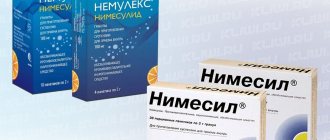Klacid
Clarithromycin inhibits the activity of the CYP3A4 isoenzyme, which leads to a slower rate of metabolism of astemizole when used simultaneously. As a result, there is an increase in the QT interval and an increased risk of developing ventricular arrhythmias.
Concomitant use of clarithromycin with lovastatin or simvastatin is contraindicated due to the fact that these statins are largely metabolized by the CYP3A4 isoenzyme, and co-administration with clarithromycin increases their serum concentrations, which leads to an increased risk of developing myopathy, including rhabdomyolysis. Cases of rhabdomyolysis have been reported in patients taking clarithromycin concomitantly with these drugs. If clarithromycin is necessary, lovastatin or simvastatin should be discontinued during therapy.
Clarithromycin should be used with caution in combination therapy with other statins. It is recommended to use statins that do not depend on the metabolism of CYP3A isoenzymes (for example, fluvastatin). If coadministration is necessary, it is recommended to take the lowest dose of statin. The development of signs and symptoms of myopathy should be monitored. When used simultaneously with atorvastatin, the concentration of atorvastatin in the blood plasma increases moderately and the risk of developing myopathy increases.
Drugs that are CYP3A inducers (for example, rifampicin, phenytoin, carbamazepine, phenobarbital, St. John's wort) can induce the metabolism of clarithromycin, which can lead to subtherapeutic concentrations of clarithromycin and a decrease in its effectiveness. It is necessary to monitor the plasma concentration of the CYP3A inducer, which may increase due to the inhibition of CYP3A by clarithromycin.
When used together with rifabutin, the concentration of rifabutin in the blood plasma increases, the risk of developing uveitis increases, and the concentration of clarithromycin in the blood plasma decreases.
When used together with clarithromycin, plasma concentrations of phenytoin, carbamazepine, and valproic acid may increase.
Strong inducers of isoenzymes of the cytochrome P450 system, such as efavirenz, nevirapine, rifampicin, rifabutin and rifapentine, can accelerate the metabolism of clarithromycin and, thus, reduce the concentration of clarithromycin in plasma and weaken its therapeutic effect, and at the same time increase the concentration of 14-OH-clarithromycin - metabolite, which is also microbiologically active. Since the microbiological activity of clarithromycin and 14-OH-clarithromycin differs against different bacteria, the therapeutic effect may be reduced when clarithromycin is used together with enzyme inducers.
The plasma concentration of clarithromycin decreases with the use of etravirine, while the concentration of the active metabolite 14-OH-clarithromycin increases. Because 14-OH-clarithromycin has low activity against MAC infections, overall activity against MAC infections may be affected, and alternative treatments should be considered for the treatment of MAC.
A pharmacokinetic study showed that co-administration of ritonavir 200 mg every 8 hours and clarithromycin 500 mg every 12 hours resulted in a marked suppression of the metabolism of clarithromycin. When co-administered with ritonavir, clarithromycin Cmax increased by 31%, Cmin increased by 182% and AUC increased by 77%, while the concentration of its metabolite 14-OH-clarithromycin was significantly reduced. Ritonavir should not be co-administered with clarithromycin in doses exceeding 1 g/day.
Clarithromycin, atazanavir, and saquinavir are substrates and inhibitors of CYP3A, which determines their bidirectional interaction. When taking saquinavir with ritonavir, consider the potential effect of ritonavir on clarithromycin.
When used simultaneously with zidovudine, the bioavailability of zidovudine is slightly reduced.
Colchicine is a substrate of both CYP3A and P-glycoprotein. Clarithromycin and other macrolides are known to be inhibitors of CYP3A and P-glycoprotein. When clarithromycin and colchicine are taken together, inhibition of P-glycoprotein and/or CYP3A may result in increased effects of colchicine. The development of clinical symptoms of colchicine poisoning should be monitored. There have been post-marketing reports of cases of colchicine poisoning when taken concomitantly with clarithromycin, most often in elderly patients. Some of the reported cases occurred in patients with renal failure. Some cases were reported to be fatal. The simultaneous use of clarithromycin and colchicine is contraindicated.
When midazolam and clarithromycin were used together (500 mg orally 2 times a day), an increase in midazolam AUC was noted: 2.7 times after intravenous administration of midazolam and 7 times after oral administration. Concomitant use of clarithromycin with oral midazolam is contraindicated. If intravenous midazolam is used concomitantly with clarithromycin, the patient's condition should be carefully monitored for possible dose adjustment. The same precautions should be applied to other benzodiazepines that are metabolized by CYP3A, including triazolam and alprazolam. For benzodiazepines whose elimination is not dependent on CYP3A (temazepam, nitrazepam, lorazepam), a clinically significant interaction with clarithromycin is unlikely.
When clarithromycin and triazolam are used together, effects on the central nervous system, such as drowsiness and confusion, are possible. With this combination, it is recommended to monitor symptoms of central nervous system disorders.
When used simultaneously with warfarin, the anticoagulant effect of warfarin may be enhanced and the risk of bleeding may increase.
Digoxin is thought to be a substrate for P-glycoprotein. Clarithromycin is known to inhibit P-glycoprotein. When used simultaneously with digoxin, there may be a significant increase in the concentration of digoxin in the blood plasma and the risk of developing glycoside intoxication.
Ventricular tachycardia of the “pirouette” type may occur with the combined use of clarithromycin and quinidine or disopyramide. When clarithromycin is coadministered with these drugs, ECG monitoring should be performed regularly to monitor for QT interval prolongation, and serum concentrations of these drugs should also be monitored. During post-marketing use, cases of hypoglycemia have been reported during co-administration of clarithromycin and disopyramide. It is necessary to monitor the concentration of glucose in the blood while using clarithromycin and disopyramide. It is believed that it is possible to increase the concentration of disopyramide in the blood plasma due to inhibition of its metabolism in the liver under the influence of clarithromycin.
Co-administration of fluconazole at a dose of 200 mg daily and clarithromycin at a dose of 500 mg 2 times a day caused an increase in the mean minimum equilibrium concentration of clarithromycin (Cmin) and AUC by 33% and 18%, respectively. However, co-administration did not significantly affect the average steady-state concentration of the active metabolite 14-OH-clarithromycin. No dose adjustment of clarithromycin is required when taking fluconazole concomitantly.
Clarithromycin and itraconazole are substrates and inhibitors of CYP3A, which determines their bidirectional interaction. Clarithromycin may increase plasma concentrations of itraconazole, while itraconazole may increase plasma concentrations of clarithromycin.
When used simultaneously with methylprednisolone, the clearance of methylprednisolone decreases; with prednisone - cases of acute mania and psychosis have been described.
When used simultaneously with omeprazole, the concentration of omeprazole increases significantly and the concentration of clarithromycin in the blood plasma increases slightly; with lansoprazole - glossitis, stomatitis and/or the appearance of a dark color of the tongue are possible.
When used simultaneously with sertraline, the development of serotonin syndrome cannot be theoretically excluded; with theophylline - it is possible to increase the concentration of theophylline in the blood plasma.
When used simultaneously with terfenadine, it is possible to slow down the rate of metabolism of terfenadine and increase its concentration in the blood plasma, which can lead to an increase in the QT interval and an increased risk of developing ventricular arrhythmias.
Inhibition of the activity of the CYP3A4 isoenzyme under the influence of clarithromycin leads to a slower rate of metabolism of cisapride when used simultaneously. As a result, the concentration of cisapride in the blood plasma increases and the risk of developing life-threatening cardiac arrhythmias, including ventricular arrhythmias, increases.
The primary metabolism of tolterodine is carried out with the participation of CYP2D6. However, in the part of the population lacking CYP2D6, metabolism occurs with the participation of CYP3A. In this population, inhibition of CYP3A results in significantly higher serum concentrations of tolterodine. Therefore, in patients with low levels of CYP2D6-mediated metabolism, a reduction in the dose of tolterodine may be required in the presence of CYP3A inhibitors such as clarithromycin.
When clarithromycin is used together with oral hypoglycemic agents (for example, sulfonylureas) and/or insulin, severe hypoglycemia may occur. Concomitant use of clarithromycin with certain hypoglycemic drugs (for example, nateglinide, pioglitazone, repaglinide and rosiglitazone) may result in inhibition of CYP3A isoenzymes by clarithromycin, which may lead to hypoglycemia. It is believed that when used concomitantly with tolbutamide, there is a risk of developing hypoglycemia.
When used simultaneously with fluoxetine, a case of the development of toxic effects caused by the action of fluoxetine has been described.
When taking clarithromycin concomitantly with other ototoxic drugs, especially aminoglycosides, caution should be exercised and the functions of the vestibular and auditory systems should be monitored both during and after therapy.
When used simultaneously with cyclosporine, the concentration of cyclosporine in the blood plasma increases, and there is a risk of increased side effects.
When used simultaneously with ergotamine and dihydroergotamine, cases of increased side effects of ergotamine and dihydroergotamine have been described. Post-marketing studies show that when clarithromycin is used together with ergotamine or dihydroergotamine, the following effects associated with acute poisoning with drugs of the ergotamine group are possible: vascular spasm, ischemia of the limbs and other tissues, including the central nervous system. Concomitant use of clarithromycin and ergot alkaloids is contraindicated.
Each of these PDE inhibitors is metabolized, at least in part, by CYP3A. However, clarithromycin can inhibit CYP3A. Concomitant use of clarithromycin with sildenafil, tadalafil or vardenafil may lead to an increase in the inhibitory effect on PDE. With these combinations, consider reducing the dose of sildenafil, tadalafil and vardenafil.
When using clarithromycin simultaneously with calcium channel blockers that are metabolized by the CYP3A4 isoenzyme (for example, verapamil, amlodipine, diltiazem), caution should be exercised as there is a risk of arterial hypotension. Plasma concentrations of clarithromycin, as well as calcium channel blockers, may increase with simultaneous use. Arterial hypotension, bradyarrhythmia and lactic acidosis are possible when taking clarithromycin and verapamil simultaneously.
Helicobacter: diagnostic measures
To diagnose Helicobacter, you need to undergo tests.
Diagnostic procedures begin with interviewing and examining the patient. Then special studies are carried out to confirm or refute the preliminary diagnosis. Tests for Helicobacter pylori:
- Non-invasive procedures - blood for specific antibodies, breath test, stool and saliva analysis
- Invasive techniques - endoscopy with collection of material for histological examination
- To determine the microorganism in biological media, PCR analysis is carried out.
- For breath tests, the patient takes a solution of urea with labeled carbon atoms. The microorganism breaks down urea, and the labeled atoms are found in the air exhaled by a person. Additionally, an analysis is carried out to determine the concentration of ammonia in exhaled air.
The most accurate results are provided only by invasive examination methods.
Bismuth preparations and proton pump inhibitors in the treatment of Helicobacter
De-nol is a bismuth-based medicine.
A bismuth-based drug, De-nol, was used even before the discovery of the pathogenic microorganism. It has an enveloping effect, forming a film on the gastric mucosa.
It protects the walls from the aggressive effects of hydrochloric acid. After the discovery of Helicobacter, it turned out that bismuth subcitrate has an inhibitory effect on the bacterium. It is able to penetrate into the deep layers of the mucous membrane, where the pathogen likes to settle.
Proton pump inhibitors - Omez, Omeprazole, Pariet - block areas of the mucosa responsible for the production of hydrochloric acid. This promotes the healing of erosions, reduces the acidity of gastric juice and allows the antibiotic molecules to be preserved in an acidic environment.
Helicobacter pylori. How to do without antibiotics?
There is no effective treatment regimen for diseases associated with Helicobacter without the use of antibiotics. Only in some cases, without symptoms of an inflammatory process in the gastrointestinal tract and with a low contamination of bacteria, is it possible to remove Helicobacter pylori from the body.
All treatment regimens place a serious strain on the body. If carriage is detected without signs of inflammation, it is recommended to use more gentle methods.
Diet for the treatment of Helicobacter pylori infection
Modern techniques allow you to be cured in a matter of weeks.
There is no specialized nutrition to combat Helicobacter. During treatment, you should adhere to the diet recommended for patients with gastritis, ulcers and other diseases of the stomach and intestines.
Food should be light, pureed and not irritate the mucous membranes. Heavy, spicy, fried and fatty foods are prohibited.
An ulcer is a dangerous disease. The cause of this pathology has now been identified. Helicobacter pylori should be treated under the guidance of a gastroenterologist. Modern techniques make it possible to get rid of this microorganism in a matter of weeks.
Traditional medicine and Helicobacter
Traditional medicine recipes should not be used without consulting a doctor.
What does traditional medicine offer for the treatment of Helicobacter? Recipes are often contradictory:
- Raw chicken eggs. It is recommended to drink 1 raw egg before breakfast. This should normalize the normal microflora of the stomach.
- St. John's wort, calendula and yarrow are mixed in equal proportions. Make a decoction - 250 ml of water per 5 g of mixture. Take the infusion 0.5 cups 3 times a day for a month.
- It is recommended to consume 1 teaspoon of rosehip syrup per month.
- Flaxseed decoction. For 1 tablespoon of seed you will need 1 glass of water. Simmer over low heat for 20 minutes. Strain the broth and take 1 tablespoon before each meal.
The use of traditional medicine recipes should only be started after consulting a gastroenterologist. Otherwise, within a month of treatment you risk getting a perforated ulcer with all the ensuing consequences.
Antibacterial drugs
Macmiror destroys the parasite's genetic material.
The choice of antibacterial drugs that can cope with Helicobacter is small. This is "Trichopol" or "Metronidazole", or "Makmiror".
Trichopolum and Metronidazole are complete analogues. The main active ingredient of the drug, metronidazole, penetrates the microorganism and breaks down, releasing toxic substances.
They destroy the parasite's genetic material. The main active ingredient of Macmiror is nifuratel. It simultaneously inhibits the growth of bacteria and prevents the proliferation of microorganisms.
The peculiarity of this drug is that nifuratel does not reduce the patient’s overall immunity, but, on the contrary, improves the body’s defenses. Macmiror is a second-line drug. It is prescribed if treatment with metronidazole does not give the expected result. This medicine is used in the treatment of peptic ulcers in children.
Long courses of treatment with NSAID drugs
There are 2 methods of treating Helicobacter pylori infection.
Treatment is carried out comprehensively. According to the WHO methodology, any drug regimen must meet the following criteria:
- Efficiency and speed
- Safety for the patient
- Convenience – use long-acting drugs, short course of treatment
- Interchangeability - any drug must be interchangeable with a complete analogue or generic
Currently, 2 methods have been adopted for the treatment of Helicobacter pylori infection. It is not recommended to use them simultaneously. If 1 scheme does not give a positive result, then the second one is used and vice versa. This prevents Helicobacter from developing immunity to drugs. Treatment regimens:
- Three-component method - 2 antibacterial drugs and 1 agent to reduce the acidity of gastric juice
- Four-component method - 2 antibacterial drugs, 1 - to reduce the secretion of hydrochloric acid, 1 - bismuth compounds
There is a 3rd treatment regimen for combating the microorganism. It is used when the first 2 did not have the desired effect. In this case, they speak of a resistant Helicobacter strain.
In this case, a preliminary endoscopic examination is carried out with the collection of material for a biopsy. In the laboratory, drugs for the treatment of Helicobacter pylori are individually selected. And only after that the doctor develops an individual course.


